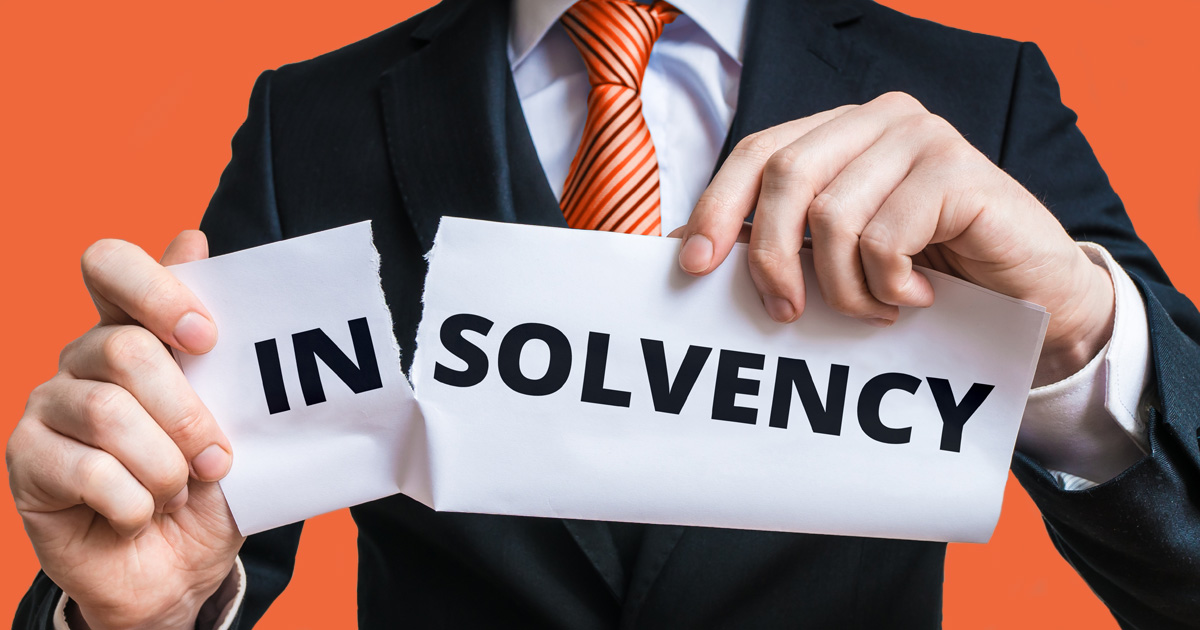Every year, over 4000 businesses go insolvent in the UK alone. In light of the ongoing late payment crisis, businesses are under more pressure than ever, leading to an increase in the number of insolvent companies.
Around 90% of all invoices are paid late, which can put immense strain on business operations.
Chaser's 2022 late payments report highlights the sheer scale of the problem, showing that businesses in the UK are owed a staggering £50 billion in overdue payments.
The combination of significant amounts of unpaid invoices and the rising number of insolvent companies has left many businesses wondering how to get their invoices paid if one of their customers goes insolvent.
Acting rapidly and proactively to secure payment is crucial. The quicker your invoice is secured, the less risk you will be exposed to in the event of insolvency. It's also essential to establish whether your customer is actually insolvent or attempting to evade payment.
To make sure you’re not left out of pocket, here are a few simple steps you can follow to maximize your chances of getting paid.
Maximizing your chances of recovering overdue payments involves swift action and understanding your role as a creditor in the insolvency process.
Determining insolvency
The first step to take when you suspect your customer may have gone insolvent is to ascertain whether this is actually the case.
Checking for signs of activity on their usual channels, such as social media or their website, is an excellent place to start.
Then you can look for official announcements about the company’s insolvency, which may be published on Companies House or in other publications, depending on the jurisdiction.
Contacting the company directly also helps to get a clearer picture. You can request an official statement from them, and you should expect one if they are still operating as usual.
Credit reference agencies such as Experian, Equifax, and Creditsafe can help you establish whether a customer has become insolvent via a credit check, but there is a cost associated with these services.
Once you've established that your customer is insolvent, you should file a Proof of Debt with their appointed liquidator. A liquidator or administrator is a court-appointed insolvency practitioner who will manage the insolvency process.
Filing a proof of debt
Filing a Proof of Debt is an official claim that you make against a debtor, indicating the amount they owe you, and it must be done for you to receive payment in the event of insolvency.
This should be done swiftly because there is usually a very limited window within which to make a claim – if you miss the deadline, your invoice may not be paid.
You must provide evidence proving the money is owed to you, such as copies of invoices and any relevant contracts.
Insolvency options for different business types
It's also essential to determine what type of insolvency proceedings are underway at the customer's company, as this will affect your options for getting paid.
Different types of businesses have access to different insolvency procedures, including:
Insolvency options for sole traders and non-limited partnerships
Two primary insolvency options exist for sole traders and non-limited partnerships: bankruptcy or Individual Voluntary Arrangement (IVA).
- Bankruptcy - Bankruptcy is an insolvency procedure where the business's assets are liquidated to pay off creditors. This also brings an end to the trading activities of the company. Specific implications for creditors come with this option, such as the lack of a payment guarantee. If the company's assets aren't sufficient to pay all creditors in full, then the debts are only partially repaid.
- Individual Voluntary Arrangement - An Individual Voluntary Arrangement (IVA) is a voluntary agreement between a debtor and their creditors. It sets out an arrangement for repaying all or part of the debt over a period of time, and the debtor is usually required to make regular monthly payments. An IVA provides creditors with a guaranteed payment as long as the debtor adheres to the terms of the agreement.
If your customer has entered into an IVA, there is a much higher chance of you recovering your invoice than if it was bankrupt.
Insolvency options for limited companies and LLPs
Four primary insolvency options exist for limited companies: administration, Company Voluntary Arrangement (CVA), Company Voluntary Liquidation (CVL), or compulsory liquidation.
- Administration - Administration is a procedure that enables a company to be rescued through restructuring and refinancing. The administrator aims to save the business rather than liquidate it, but this outcome isn’t guaranteed. This represents the highest chances of recovery for creditors as the debtor has a higher chance of survival.
- Company Voluntary Arrangement - A Company Voluntary Arrangement (CVA) is an agreement between a company and its creditors that sets out terms for repaying all or part of the debt over a period of time. Like an IVA, it provides creditors with a guaranteed payment provided the debtor adheres to the terms of the agreement.
- Company Voluntary Liquidation - A Company Voluntary Liquidation (CVL) is a procedure where a company’s assets are liquidated to pay creditors what they are owed. This option has less impact than compulsory liquidation and gives the business more control over its future.
- Compulsory liquidation - Compulsory liquidation is a procedure where a company’s assets are liquidated to pay creditors what they are owed. This option has more impact than CVLs and gives the business less control over its own future, as either creditors or shareholders initiate it. As with bankruptcy, creditors have no guarantee of repayment and may only receive a fraction of what they are due.
Administration or a CVA maximize your chances of recovering your invoice, while CVL or compulsory liquidation reduce them significantly.
Understanding your role
The best way to maximize your chances of recovering the money you’re owed is to understand your role as a creditor in the insolvency process.
You should familiarize yourself with the applicable laws and regulations and the type of insolvency proceedings your customer is pursuing. This will help you determine which steps to take and when it is best to pursue them.
Communicating with the appointed insolvency practitioner should be your priority, and you should ensure that they have all relevant documents and information. This could include copies of invoices, contracts, or other evidence that proves the debtor owes you money.
At the same time, if there is any chance your customer might survive, as in the case of an IVA or administration, it’s vital to remain open-minded and supportive. A cooperative approach can help ensure the best outcome for all parties involved.
Ensuring you are kept in the loop, pursuing your rights as a creditor, and staying informed of the insolvency process is the key to maximizing your chances of recovering what you are owed.
Mitigating losses
As mentioned, the chances of you recovering the money you are owed depend on the type of insolvency proceedings your customer is pursuing.
If it has entered into an IVA or administration, there is a much higher chance than if it was bankrupt or in compulsory liquidation.
Taking proactive steps to mitigate losses and minimize potential damage to your business is essential. There are several steps you should take, including:
- Identifying client assets - Investigating whether the customer owns any valuable assets can help you identify the funds available to pay the debt.
- Filing a lien against assets - Once you have identified assets, it’s essential to establish a lien against them. This will ensure that you are repaid before other creditors if the assets are sold.
- Making a claim with the insolvency practitioner - The insolvency practitioner must investigate and determine the validity of your claim. You should provide all relevant documents and information to prove your claim.
Taking these steps quickly and accurately is the key to maximizing your chances of recovering your debts.
Retention of title clauses
If you have provided products to the customer for sale before they became insolvent, you may have a claim for retention of title.
A retention of title clause, also known as ROT, stipulates that the ownership of goods remains with you until they are paid for. This allows you to take back any products supplied and sell them to recover your debt.
If the customer sells the products before paying for them, you have a claim to the proceeds of that sale.
Enforcing retention of title clauses depends on the law in your jurisdiction and the type of insolvency proceedings your customer is going through. It’s essential to seek legal advice before taking action, as this could have significant implications for your business.
ROT clauses are complex, and not all goods can be subject to them. It’s essential to check whether your contract includes a ROT clause and to seek legal advice on how best to proceed.
Utilizing data and staying in contact
As mentioned, open communication between creditors and the insolvency practitioner is essential to maximize the chances of a successful outcome.
Staying in contact with the insolvency practitioner will help you remain informed of developments and take appropriate steps when necessary.
Using the insolvency practitioners' data can also give you a better idea of the progression of the proceedings and the chances of retrieving your money.
It can also be a great way to identify assets or liabilities you might not have been aware of before. Knowing this information can help you decide how best to pursue your claim.
Open and honest communication with the customer can also propagate a future relationship if the business survives. It’s essential to remain open-minded and supportive, as this could help ensure the best outcome for all parties involved.
Building a reputation as a reliable and fair creditor is critical. This will help you establish credibility with customers, the insolvency practitioner, and other creditors in the future.
Navigating the challenges of insolvency
Having a customer go into insolvency can be a difficult and daunting experience for creditors.
However, understanding your rights, taking proactive steps to mitigate losses, and staying informed of the process can help you maximize your chances of recovering your debts.
By keeping yourself apprised of applicable laws and regulations, communicating openly with the appointed insolvency practitioner, and utilizing data to your advantage, you can ensure the best possible outcome for both you and the customer.
Of course, an ounce of prevention is worth a pound of cure when it comes to financial risk.
Chaser's cutting-edge credit control features, such as built-in credit checking, a late payment predictor, and automated reminders (coupled with the new recommended chasing times), can help you streamline the debt collection process and give your accounts receivables team the tools they need to stay on top of customer payments.
To learn more about how Chaser can empower you to stay proactive and prepared, to ensure your business's cash flow stays healthy, book a demo with one of our experts today or start your no-obligation 14-day free trial.




%20-%20Accounts%20receivables%20management_%205%20tips%20to%20improve%20your%20AR.webp?width=400&height=225&name=Blog%201%20(Sep)%20-%20Accounts%20receivables%20management_%205%20tips%20to%20improve%20your%20AR.webp)